Finch struggles, Maxi’s role and heroes return — biggest hurdles facing Australia’s WC title defence
Australia has won just four of their past 29 ODIs, yet are third favourites to defend their World Cup title. To do so, they need to answer these huge questions which will shape their campaign.
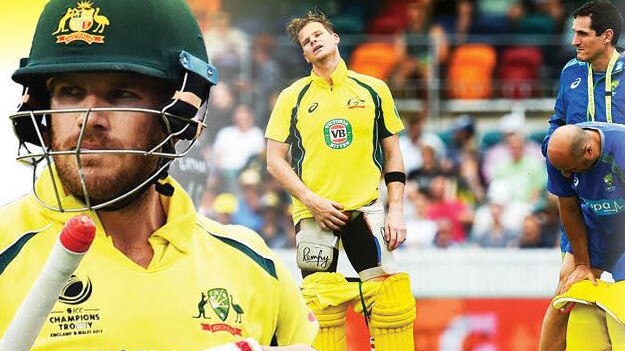
Cricket
Don't miss out on the headlines from Cricket. Followed categories will be added to My News.
For a team that has won just four one-day games dating back more than two whole years, it seems remarkable that Australia remains third favourite to defend their World Cup title in England this year.
But that’s how the market stands. And to do so, Australia will need to fix some serious issues.
Australia’s first two games against India this series have gone down to the wire — which could be viewed as a sign that this team, competing against one of the World Cup favourites on their home soil, is not as far off as their world ranking of sixth and recent win-loss record suggests.
But there are serious questions facing Justin Langer and his squad, even before they arrive in England.
WHAT TO DO WITH FINCH?
Barely four months ago Aaron Finch’s World Cup spot was in absolutely no danger, as he plundered a matchwinning knock against South Africa.
Now? The opener is facing not only losing the captaincy — but his spot altogether.
On Tuesday night in Nagpur, Finch showed glimpses of his best as he patched together a 37 in a vastly improved showing.
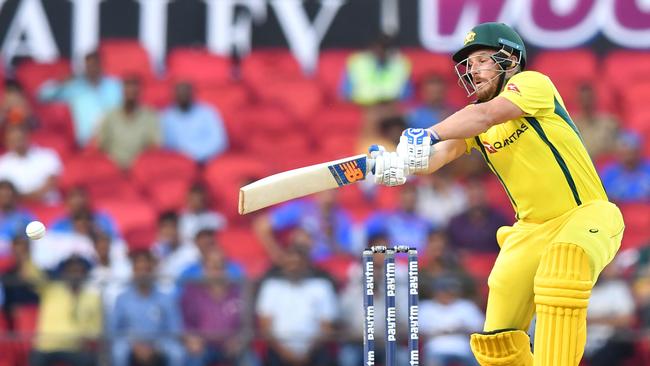
But was it enough to silence the doubters? It was his best knock since November — a five-innings stretch in which he notched three single figure scores.
But there remain serious concerns about his form since his Test debut in October, a period in which he hasn’t had a white-ball half-century.
“It’s a major concern and it’s been a problem for a while,” said former Australian captain Ian Chappell on Macquarie Sports Radio.
“It could get to the point where you’re going to have to drop your captain in the middle of the World Cup if he doesn’t get some runs.”
MORE CRICKET NEWS
COLLAPSE: Exposing West Indian cricket’s greatest myth
HERO: Meet the man reviving cricket’s glory days
The big thing working in Finch’s favour as far as his World Cup hopes go is that there’s no clear captaincy options lining up to replace him, with Alex Carey’s grip on the deputy role also tenuous.
“But I’ll say that his poor batting hasn’t affected his captaincy, I thought he did a good job in the field last night,” Chappell added.

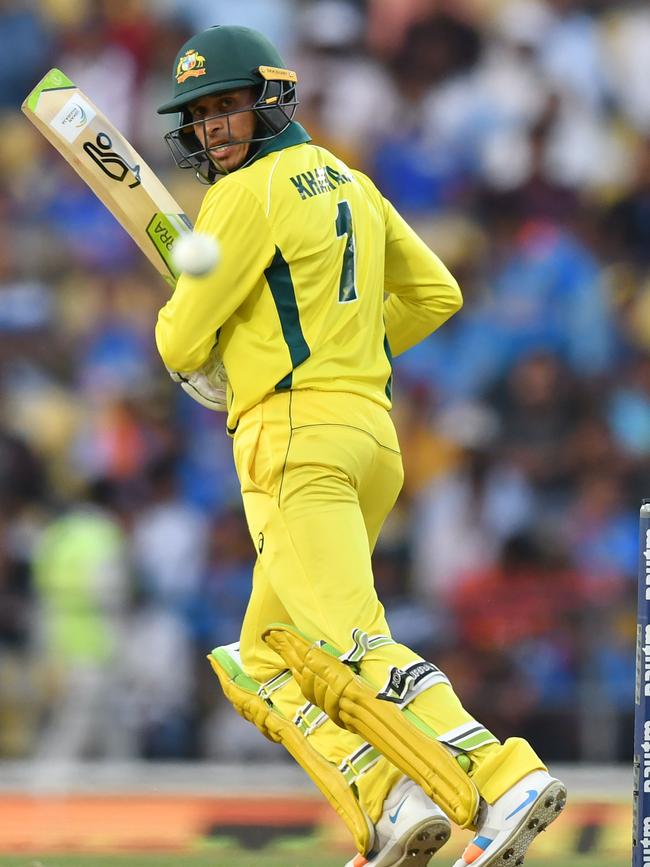
WHAT IS THE BEST BATTING LINEUP?
For the third consecutive ODI, Australia reshuffled the deck chairs in the batting order — proving that even three months out from their title defence, Justin Langer doesn’t truly know how best to fit all the pieces in this puzzle.
There have been three different options used at first drop — Usman Khawaja, Marcus Stoinis and Shaun Marsh — and a mix of opening partnerships as well.
In short, it’s all a bit of a dog’s breakfast.
The two players shuffled around the least — under-pressure skipper Finch and middle-order batsman Peter Handscomb — are no certainties to retain their spots when the tournament.
Going back to the South Africa series at the start of the summer, Australia’s team looked different once again. Think Chris Lynn, Travis Head and D’Arcy Short.
The Lynn experiment is dead in the water. For all of his explosive potential and BBL pedigree, Short simply hasn’t delivered at international level, and he too seems to have been left behind.
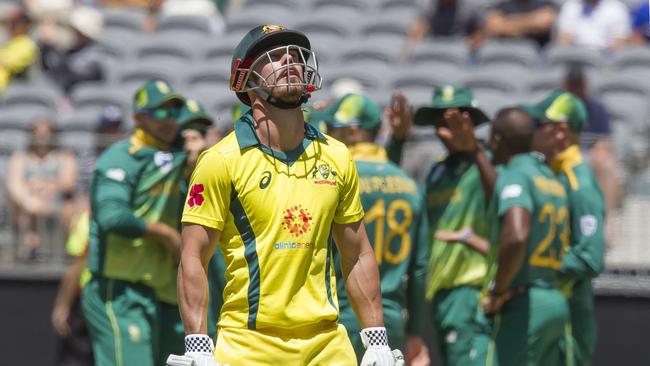
Head was left in Australia to play Sheffield Shield cricket — though it’s unclear if that was a plan to focus on red-ball cricket with the Ashes in mind, or whether he really has fallen off the ODI radar and his Cup hopes are dashed.
What is clear is that Australia is still tinkering with its top six — and that’s before you factor in the looming changes to the bowling attack and the arrival of two players who could shift the dynamic of the team considerably.
Which brings us to our next point…
HOW TO REINTEGRATE SMITH AND WARNER?
Without a doubt the biggest question mark hanging over the Australian team, and it’s one which has been there for the best part of a year now.
There have been clear signs that the reintegration is already underway, with both Steve Smith and David Warner invited to take part in Australian and NSW training over summer.

Publicly, players have been unanimous in saying the stars will be welcomed back with open arms. But the reality of them coming back into the dressing room will present different challenges which won’t be felt until it actually happens.
Having two alpha dogs rejoining the pack so close to a major event — especially in reduced roles, certainly from a leadership perspective — could rock the boat, requiring a delicate touch to keep everybody happy.
And then there’s the contributions of the players on the field.
It’s hard to gauge just how well the pair will go with bat in hand — with both coming off elbow surgeries, and having played only T20 tournaments for the past 12 months.
Aussie legend Shane Warne said on Tuesday he was confident that the cream would rise to the top, pointing to his own 12-month ban — for taking a banned diuretic — and success upon his return as proof that Smith and Warner would deliver on the big stage.

Warner has been among the world’s best ODI batsmen for years now, and his 14 centuries ranks him fourth on Australia’s all-time list.
With Australia’s top order in a complete state of flux, Warner should walk back in and take ownership of one openers spot — with a nation crossing its fingers that he hasn’t lost the magic.
More concerning for Australia should be Smith’s ODI numbers.
Even before his year-long ban, and despite his extraordinary Test form which cemented his place as the best red-ball batsman on the planet, Smith was not exactly setting the world on fire in the 50-over format.
Only once in his past 12 ODI knocks has Smith had a strike rate above 100. He’s hit just one century in his past 20 digs, and passed 50 just three times in his past 15.
Though his career average of 41.84 suggests he’s obviously worth taking a punt on, obviously.

HOW TO BEST USE GLENN MAXWELL?
Glenn Maxwell is a player who naturally invites debate, but there’s no doubt he is firmly in Australia’s best XI.
However how does Australia get the best out of their explosive matchwinner?
During the home summer Langer felt there was no doubt Glenn Maxwell’s best spot in Australia’s ODI line-up was at No.7.
Maxwell’s blazing T20 century against India last week was proof he can make an enormous impact in a short time, adding weight to Langer’s argument.
But it was a view criticised by World Cup-winning captain Allan Border, who described it as a ‘waste’ having Maxwell batting so low — and said he’d lock the Victorian in at four.
Surely having your key batsman facing more balls puts Australia in a better position, right?
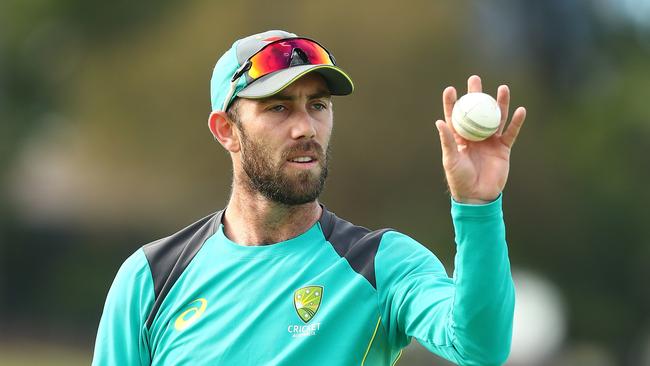
That might have been the inspiration behind Maxwell moving up to five in the ongoing series with India — where he produced scores of 40 and 4 in the opening two games.
Leading statistician Ric Finlay outlined Maxwell’s destructive power using a formula which combined the runs scored per boundary ball and the runs scored per non-boundary ball.
Finlay said the formula analyses a player’s powerhitting ability (for boundaries) and guile.
Maxwell was the only Australia to rank in the top ten when the two measures were combined.
Combining the two measures together to find the best impact batsmen:
— Ric Finlay (@RicFinlay) March 4, 2019
1. Shahid Afridi
2. ABdeV
3. JButtler
4. NPerera
5. DMiller
6. GMaxwell
7. JPDuminy
8. SRaina
9. MhdNabi
10. JRoot https://t.co/bLrU5cjcxW
FITNESS DOUBTS OVER STAR QUICKS?
Mitchell Starc and Josh Hazlewood are the only remaining bowlers from Australia’s 2015 World Cup campaign — and their title-winning pedigree will be in great demand.
But both are sidelined with untimely injuries after a long summer.
Starc said over the weekend that he was behind in his recovery from a pectoral injury, but remains optimistic of being fit for Australia’s one-day series against Pakistan in the UAE later this month.
Hazlewood has a back injury and won’t be fit to until Australia's World Cup warm-ups in England.
Having both fit and firing is absolutely essential, especially in addition to the emergence of Pat Cummins as a white-ball force.
Originally published as Finch struggles, Maxi’s role and heroes return — biggest hurdles facing Australia’s WC title defence


